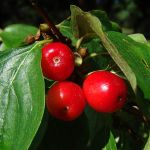| Common Name: |
Cornelian Cherry |
| Other Names: |
Japanese cornel |
| Botanical Name: |
Cornus officinalis |
| Genus: |
Cornus |
| Family: |
Cornaceae |
| Native Location: |
China, Japan, Korea |
| Cultivation: |
Well-drained soil in sun or partial shade. |
| Propagation: |
By seed in autumn, or stratified and sown in spring; by greenwood cuttings in summer. |
| Harvest: |
Fruits are collected when ripe and dried for use in decoctions. |
| Height: |
5-10m (15-30ft) |
| Width: |
5-10m (15-30ft) |
| Hardiness: |
Z4-8 |
| Parts Used: |
Fruits (shan zhu yu) |
| Properties: |
A sour, astringent, diuretic herb that acts mainly as an energy tonic for the liver and kidneys. It also checks bleeding, lowers blood pressure, and controls bacterial and fungal infections. |
| Medicinal Uses: |
Internally to reduce excessive secretions and discharge (such as profuse perspiration, frequent urination, or heavy menstruation), and for conditions associated with weak kidney and liver energy (such as urinary dysfunction and impotence). Often combined with Rehmannia glutinosa (See, Chinese Foxglove) to suppress excretion of fluids. |
| Warning: |
Skin allergen |
| Bibliography: |
Encyclopedia of herbs by Deni Brown Copyright © 1995, 2001 Dorling Kindersley Limited. pg 180-181 |

